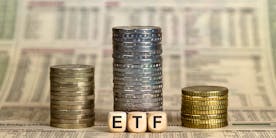What Is an ETF (Exchange-Trading Fund)? Definition and How Does it Work?
An ETF, or Exchange-Trading Fund, is an investment fund that tracks the performance of an underlying index, such as the S&P 500.
It is traded on stock exchanges, just like individual stocks, and exposes investors to a diversified portfolio of securities.
In this article, we will delve into the definition of an ETF and how it works, explore the different types of ETFs available, discuss the advantages of investing in ETFs, highlight the risks and considerations associated with investing in these funds and provide a guide on how to begin investing in ETFs.
Definition of an ETF
Before we dive into the intricacies of ETFs, let's start with a simple definition.
An ETF is an investment fund that holds a basket of assets, such as stocks, bonds, or commodities. It is designed to track the performance of a specific index, sector or asset class.
Unlike mutual funds, which are only priced at the end of the trading day, ETFs can be bought and sold throughout the trading day at market prices.

ETFs offer investors a convenient way to gain exposure to a diversified portfolio of securities without purchasing each security separately. They are often seen as a cost-effective alternative to mutual funds, as they typically have lower expense ratios and offer better tax efficiency.
One of the key advantages of ETFs is their transparency.
Since ETFs are traded on exchanges, their holdings are disclosed daily, allowing investors to see exactly what assets the fund holds. This level of transparency provides investors with a clear understanding of the underlying securities they are investing in.
Furthermore, ETFs can offer investors access to a wide range of markets and asset classes that may be difficult to access through individual securities. For example, some ETFs track specific sectors like technology or healthcare, as well as ETFs that provide exposure to international markets or alternative investments like commodities and real estate.
How ETFs Work
ETFs are investment vehicles structured as open-ended companies or unit investment trusts. They provide a unique way for investors to access a diversified asset portfolio.
A significant aspect of ETFs is their creation and redemption process, which is managed by authorized participants (APs).
APs are essential for maintaining ETF efficiency and liquidity as they create or redeem shares in response to market demand.
Large financial institutions or market makers, known as authorized participants, collaborate with ETF issuers. Together, they adjust the number of outstanding shares to match investor demand. This process maintains the ETF's market price close to its underlying net asset value (NAV), ensuring price efficiency and reducing arbitrage opportunities.
Furthermore, ETFs offer investors the flexibility to trade throughout the trading day on stock exchanges, unlike traditional mutual funds priced once a day after the market closes. This intraday trading feature allows investors to react quickly to market developments and adjust their positions as needed.
The ability to buy and sell ETF shares at market prices provides investors with transparency and real-time pricing information, enhancing the overall trading experience.
Types of ETFs
There are different types of ETFs available to investors, catering to various investment objectives and strategies.
Let's take a closer look at some common types of ETFs:
-
Equity ETFs – Equity ETFs follow a particular stock index or a collection of stocks, providing investors exposure to a broad market index (e.g., S&P 500) or a specific sector. This enables participation in the performance of underlying stocks without the need to buy each stock individually.
-
Bond ETFs – Bond ETFs invest in fixed-income securities like government, corporate, or municipal bonds. They offer exposure to the bond market, enabling investors to diversify their fixed-income holdings. Bond ETFs are appealing to those seeking regular income and a lower risk level than equities.
-
Commodity ETFs – Commodity ETFs follow the performance of commodities like gold, silver, oil or agricultural products. Investors can invest in these physical assets without direct ownership. Commodity ETFs are favored by those seeking portfolio diversification and a hedge against inflation or geopolitical risks.
-
Currency ETFs – These ETFs track the performance of foreign exchange markets, allowing investors to gain exposure to various currencies without directly trading forex. However, unlike traditional forex trading, Forex ETFs are traded on exchanges like stocks, providing investors with the convenience of buying and selling currencies through a familiar investment vehicle.
-
International ETFs – International ETFs offer exposure to foreign markets for geographical portfolio diversification. They track the performance of international stock exchanges or specific country indices. Investing in these ETFs can provide potential growth opportunities and allow investors to capitalize on global economic trends.
-
Factor ETFs – Factor ETFs concentrate on specific investment factors like value, growth, momentum, or low volatility, aiming to capture associated excess returns. Investing in these ETFs allows investors to implement a factor-based strategy, potentially enhancing their portfolio's risk-adjusted returns.
-
Inverse ETFs – Inverse ETFs seek to profit from a decline in the value of an underlying index or asset class by employing derivatives like futures contracts. Investors can utilize these ETFs to hedge or speculate on market downturns.
These are just a few examples of the types of ETFs available in the market. Each type caters to different investment strategies and risk profiles. It is important for investors to carefully consider their investment objectives, risk tolerance and time horizon before investing in any ETF.
Conducting thorough research and consulting with a financial advisor can help investors make informed decisions and build a well-diversified portfolio.
Advantages of Investing in ETFs
Investing in ETFs offers several advantages over other investment vehicles. Some key benefits include:
-
Portfolio Diversification – ETFs provide investors with instant diversification by investing in a basket of securities. This helps spread risk and reduce the impact of individual stock or bond performance on the overall portfolio.
-
Lower Costs – ETFs typically have lower expense ratios than mutual funds. They also offer intraday liquidity and efficient trading, which can help reduce transaction costs.
-
Tax Efficiency – ETFs are structured to minimise capital gains distributions, resulting in better tax efficiency than mutual funds.
-
Flexibility – ETFs can be bought and sold throughout the trading day at market prices. This allows investors to enter or exit positions anytime during market hours, allowing for enhanced portfolio management.
-
Transparency – ETFs must disclose their holdings daily, giving investors a clear view of the fund's assets. This transparency can help investors make more informed decisions and better understand the risks associated with the ETF.
These advantages make ETFs an attractive investment option for individual and institutional investors. However, it is important to note that ETFs also have risks and considerations that need to be considered.
Risks and Considerations of Investing in ETFs
While ETFs offer numerous benefits, investors should know the risks and considerations associated with these funds.

Some of the key risks include:
-
Market Risk – Like any investment, ETFs are subject to market risk. The value of an ETF can fluctuate based on the performance of the underlying securities and market conditions.
-
Liquidity Risk – While ETFs offer liquidity, there may be instances where the underlying securities have limited trading volume, leading to potential liquidity challenges for the ETF.
-
Tracking Error – ETFs aim to track the performance of an underlying index, but they may not perfectly replicate the index's returns. This can be due to fees, transaction costs and dividend reinvestment.
-
Counterparty Risk – Some ETFs use derivatives or engage in securities lending to achieve their investment objectives. This introduces counterparty risk, as the ETF is reliant on the counterparty's ability to fulfill its obligations.
-
Investor Due Diligence – Before investing in any ETF, investors must carefully assess risks and perform due diligence. Understanding the chosen ETF's specific investment strategy and objectives is crucial as it directly influences its risk profile.
-
Regulatory Risk – Regulation changes can affect an ETF's operations and performance, impacting tax treatment or imposing restrictions on held assets.
-
Currency Risk – ETFs with international securities are exposed to currency risk. Fluctuations in exchange rates can impact investment values when converted to the investor's base currency, adding an extra layer of risk to consider when evaluating ETF options.
How to Begin Investing in ETFs
Here are some additional steps and insights to help you get started:
Step 1. Set Investment Objectives
Determine your investment goals and risk tolerance. Consider your time horizon, income requirements and asset allocation. It's important to clearly understand what you hope to achieve with your investments, as this will guide your decision-making process.
Step 2. Research ETFs
Conduct thorough research on available ETFs. Consider expense ratios, tracking error, holdings and performance history. Look beyond the surface-level information and dig deeper into the underlying assets and strategies of each ETF. This will help you make informed decisions and choose funds that align with your investment objectives.
Step 3. Select a Brokerage Account
Choose a brokerage firm that offers access to a wide range of ETFs and provides low-cost trading. Evaluate factors such as account fees, trading platforms and customer support. It's important to find a brokerage that suits your needs and offers the necessary tools and resources to help you navigate the world of ETF investing.
Step 4. Open an Account
Follow the steps provided by the brokerage to open an account. Provide the necessary information and complete any required documentation. Opening an account is a straightforward process, but providing accurate information and complying with legal requirements is crucial.
Step 5. Execute Trades
Once your account is set up, start buying ETFs using the brokerage's platform or seek advice from a financial advisor. Since ETFs trade like stocks, specify the number of shares and desired purchase price. Be mindful of market conditions and execute trades aligned with your investment strategy.
Step 6. Monitor and Rebalance
Regularly review and monitor your ETF holdings. Adjust your portfolio to align with investment objectives by assessing ETF performance, rebalancing for desired asset allocation and staying informed about market changes. Monitoring and rebalancing are crucial for aligning investments with long-term goals.
By following these steps and staying informed about ETF investing, you can begin your journey into investing in ETFs and take advantage of the benefits they offer. Investing involves risks, and it's important to do your due diligence and seek professional advice if needed.
Happy investing!
Frequently Asked Questions
It depends on your investment goals. ETFs offer diversification, while stocks provide individual ownership.
ETFs may not be suitable if you seek high-risk, high-reward opportunities or desire direct company ownership.
ETFs can generate returns through market gains and dividends, but success depends on market performance and the specific ETF's holdings.
An ETF (Exchange-Traded Fund) is a type of investment fund that holds a diversified portfolio of stocks, bonds, or other assets. It trades on stock exchanges like a single stock, providing investors with diversified exposure to various assets and offering liquidity through easy buying and selling on the market.
ETFs (Exchange-Traded Funds) are investment funds that trade on stock exchanges, comprising a diversified portfolio of stocks, bonds or other assets. They offer investors a convenient way to gain exposure to a broad market or specific sectors, combining the benefits of diversification and ease of trading like individual stocks.
Final Thoughts
An Exchange-Traded Fund (ETF) is an investment fund that tracks the performance of an underlying index and is traded on stock exchanges.
ETFs provide a cost-effective and transparent way for investors to gain exposure to diversified securities portfolios, offering advantages such as instant diversification, lower costs, tax efficiency and flexibility in trading.
There are various types of ETFs, including Equity ETFs, Bond ETFs, Commodity ETFs, International ETFs, Factor ETFs and Inverse ETFs, each catering to different investment strategies.
Despite their benefits, investors must be aware of associated risks, such as market risk, liquidity risk, tracking error and counterparty risk. Thorough due diligence and careful consideration of investment goals and risk tolerance are essential before investing in ETFs.
To start investing in ETFs, set clear investment objectives, conduct thorough research on available ETFs, choose a suitable brokerage account, open an account, execute trades based on market conditions and your strategy and regularly monitor and rebalance your portfolio to align with long-term goals. This straightforward process and staying informed about ETF investing allow investors to take advantage of the benefits while managing potential risks.




